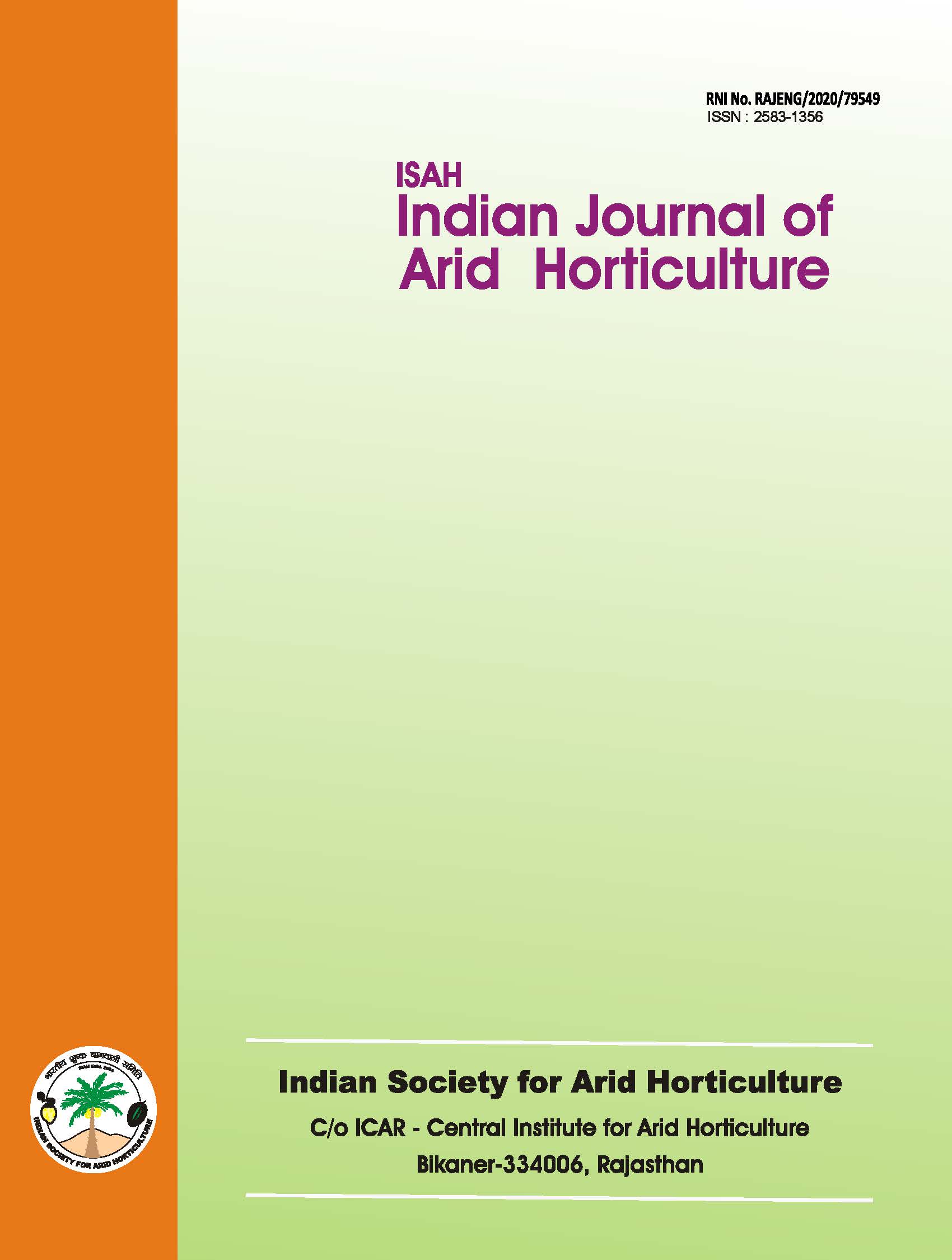Estimation of genetic variability parameters in aloe (Aloe barbadensis Mill.) genotypes to improve economic traits
DOI:
https://doi.org/10.48165/ijah.2024.6.2.10Keywords:
Genetic variability, aloin, yield, Aloe barbadensisAbstract
A study was conducted on twenty-six accessions of Aloe barbadensis Mill. at ICAR DMAPR, Boriavi, from 2019 to 2021 to assess morphological, chemical, and yield traits for identifying elite lines suitable for herbal drugs and cosmetics. Significant variation among accessions was observed among the evaluated genotypes. IC 310623 demonstrated superior gel and aloin yield, with high aloin content, making it ideal for medicinal and cosmetic applications. High genetic and phenotypic coefficients of variation (GCV and PCV) were noted for leaf thickness and exudates yield per plant, suggesting that direct selection for these traits could enhance future breeding programs. This study identifies promising accessions with potential for commercial exploitation in herbal and cosmetic industries.Downloads
References
Ahmad, M. A. and Gupta, L. M. 2016. Genetic variability, correla tion and path coefficient analysis of some yield related traits in aloe (Aloe barbadensis Mill.). Indian Journal of Horticulture, 73 (2):251-255. 10.5958/0974-0112.2016.00056.6
Alagukannan, G. and Ganesh, S. 2008. Genetic variability for eco nomic traits in Aloe vera L. Journal of Medicinal and Aromatic Plant Sciences, 31: 25-28.
Allard, R. W. 1960. Principle of Plant Breeding. Published by John Willey and Sons, Inc., New York.
Atherton, P. 1998. Aloe vera: magic or medicine? Nursing Stan
dard, 12(41): 49.
Bhat, M. and Devi, P. 2010. Aloe vera: A nature’s gift to children. In ternational Journal of Clinical Pediatric Dentistry, 3:87-92. https://doi.org/10.5005%2Fjp-journals-10005-1059.
Burton, G. W. 1952. Quantitative inheritance in grass. In: Proceed ings of 6th International Grassland Congress.1:277-283. Falconer, D.S. 1981. Introduction into Quantitative Genetics. 3rd edition Longman, New York.
Gajbhiye, N. A. and Maiti, S. 2010. Distribution of aloin-A in dif ferent leaves of aloe. Indian Journal of Horticulture, 67 (4):63- 566.
Hanson, C.H., Robinson, H.F and Comstock, R.K. 1956. Biomet rical studies on yield in segregating population of Korean Las phadezia. Agronomy Journal, 48: 314-318.
Johnson, H. W., Robinson, H. O. and Comstock, R. E. 1955. Es timates of genetic and environmental variability in soybean. Agronomy Journal, 47:314-318.
Liu, X., Li, J., Zhang, Y., Li, L. and He, D. 2011. Biological re search advancement in aloe. Journal of Medicinal Plants Re search, 5(7):1046-1050. http://www.academicjournals.org.
Manvitha, K. and Bidya, B. 2014. Aloe vera: a wonder plant its his tory, cultivation and medicinal uses. Journal of Pharmacognosy and Phytochemistry, 2(5):85-88.
Misir, J., Brishti, F.H. and Hoque, M.M. 2014. Aloe vera gel as a nov el edible coating for fresh fruits: A review. American Journal of Food Science and Technology, 2(3):93-97. 10.12691/ajfst-2-3-3.
Okamura N., Hine N., Harada S., Fujioka T. and Yagi A. 1996. Three chromone components from Aloe vera leaves. Phytochemistry, 43:495-498. http://dx.doi.org/10.14303/irjps.2012.040.
Okareh, O.T., Enesi, D. and Shittu, O.I. 2012. Ecological influence on selected Aloe vera populations in two geographical zones in Nigeria. International Research Journal of Plant Science, 3(5):
88-93. http://dx.doi.org/10.14303/irjps.2012.040.
Panse, V. G. and Sukhatme, P. V. 1978. Statistical Methods for Ag ricultural Workers. ICAR Publication.
Reddy, C.U., Komar, S.R. and Jaddu, J.R. 2011. Aloe vera - a wound healer. Asian Journal of Oral Health Allied Sciences, 1:91-92. Saeed, M. A., Ahmad, I., Yaqub, U., Akbar, S., Waheed, A., Sal eem, M. and Din, N. 2004. Aloe vera: a plant of vital signifi cance. Quarterly Science Vision, 2:1-13.
Samsai, T. and Praveena, S. 2016. An analysis of production and processing of Aloe vera. International Journal of Agricultural Science and Research, 6(6):51-56.
Viljoen, A.M. and van Wyk, B.E. 2000. The chemotaxonomic sig nificance of the phenyl pyrone aloenin in the genus Aloe. Bio chemical Systematics and Ecology, 28: 1009–1017. https://doi. org/10.1016/S0305-1978(00)00018-1.

